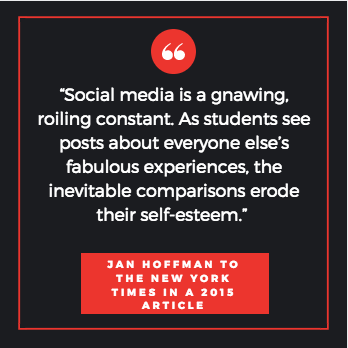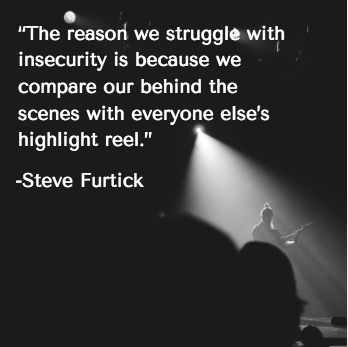February 26th – March 4th, 2018 is National Eating Disorders Awareness week. This year’s theme is “Let’s Get Real.” Read more about the campaign and how you can get involved here.
A picture is worth a thousand words.
Every picture tells a story; however, it may not always be the story we assume, especially in the case of social media posts. Those carefully curated snapshots in time often tell only a tiny piece of the story, and their ramifications on our perception of reality are definitely not shown.
In alignment with the 2018 National Eating Disorder Awareness Week’s theme “Let’s Get Real,” I’m exploring the question of how these stories might impact our self-esteem, body image, and mental and physical health. While this issue affects both genders, I relate to it more as it applies to women and thus am exploring it through a female lens.
TELL ME I’M PRETTY
Appearance standards have always existed, manifesting differently depending on the context: the standard of plumpness of the late 1800s, to the pencil-thin flappers of the 1920s, to the curvy women of the 1940s and 1950s, to the thin ideal of Twiggy in the 1960s, and so on.
As Joan Jacobs Brumberg, author of The Body Project, explained in an interview with Glamour magazine, it wasn’t until about the 1920s that “girls started using the word image—and learned that this image was malleable with dieting, makeup, and clothes; that it was something they were supposed to control.” Up until that point, people “accepted their body as pretty much a given.” This feeling that physical appearance is an area of control, along with appearance standards set by society, can become a psychologically torturous combination.
Before the Internet came around, there was far less exposure to societal ideals. Now, thanks to social media, self-comparison has become a daily occurrence.

According to a 2014 study, 1.8 billion photos are uploaded and shared on Facebook, Instagram, Flickr, Snapchat, and WhatsApp online every day. As of 2017, the time spent on the Internet on mobile devices averages out to about 5.6 hours/day. Over the course of a year, that’s roughly 2000 hours or 85 days!
Jesse Fox, an Ohio State University professor who runs a lab that investigates self-image, hypothesizes that this growing exposure to media (especially social media) is a key reason for the rise in body dissatisfaction found among women in a 1984 and 2014 Glamour survey. 54% of women reported being unhappy with their body (compared to 41% in 1984), and 64% of the women in the 2014 survey reported that “looking at pictures on Facebook and Instagram made them feel bad about their body.”
Why would this be? Perhaps because these images on social media sites are predominantly our peers and friends, rather than celebrities who have teams of people to help them achieve the “perfect” image. We compare ourselves to them and may think, “If they can do it, I can too.”
WHEN IT’S TOO MUCH
This desire to control our appearance to match what is perceived as acceptable can lead to detrimental consequences. As a dietitian, I am obviously most concerned about the impact on eating and health-related behaviors.
Reaching for acceptance through controlling one’s appearance can become a dangerous obsession. The National Eating Disorder Association (NEDA) website reports that an estimated 20 million women and 10 million men in America will have an eating disorder in their lifetime. According to the Eating Disorder Hope website, the prevalence of eating disorders and similar behaviors is much higher in teen and college years. 50% of teenage girls and 30% of teenage boys “engage in unhealthy weight control behaviors such as skipping meals, fasting, smoking cigarettes, vomiting, and taking laxatives to control their weight.” 91% of women surveyed on a college campus had “attempted to control their weight through dieting,” with 22% dieting “often or always.” This is concerning given that “35% of dieters progress to pathological dieting,” of which 20-25% develop a “partial or full-syndrome eating disorder.”
Interestingly, statistics also show that teenagers and college-age folks are the biggest users of social media. A 2018 PEW Research Center Survey showed that 88% of US adults between the ages of 18-29 report using social media, the highest percentage of any of the age groups surveyed.
Whatever the age of onset, eating disorders have the highest mortality rate of any mental illness and can lead to undesirable health outcomes including osteoporosis and severe nutrient deficiencies. They have been known to end athletes’ careers. Not to mention, they rob a person of years of joy and living life to its fullest.
Even if one does not go to these extremes, poor self-esteem resultant from appearance standards and self-comparison can have other damaging effects on health and well-being. In her 2014 TED Talk titled “Why Thinking You’re Ugly is Bad for You,” Meaghan Ramsey, the Global Director of the Dove Self-Esteem Project, explains that “teenagers with low body confidence do less physical activity, eat less fruits and vegetables, partake in more unhealthy weight control practices…have lower self-esteem…and are at a greater risk of depression.”
Knowing all of this, how do we combat poor self-esteem, disordered eating, and eating disorders when a huge contributor, media exposure, is here to stay?
OUR TECHNOLOGIES ARE BROKEN
Hugh Herr, the head of the biomechanics research group at MIT, lost both of his legs after a mountain climbing accident. He was told he would probably not be able to walk again, let alone partake in his passions for hiking and climbing. Instead of succumbing to his circumstances, Herr found a way to work with the very technology that was holding him back by designing bionic limbs that allowed him to, once again, climb mountains and live the full life he desired to live. His technology has similarly enabled others to walk, dance, climb, and live again.
![Black square with red border. Quote in white font: "A person can never be broken. Our built environment, our technologies, are broken and disabled. We the people need not accept our limitations, but can transcend [them] through technological innovation." Hugh Herr, head of the Biomechanics Research Group at MIT](https://peaceandpancakes.com/wp-content/uploads/2018/02/screen-shot-2018-02-27-at-1-27-04-pm.png)
While Herr’s story is much different than that of simply combating self-esteem, his idea that our “technologies are broken” rings true for this issue. The usage of the Internet, social media, and smartphones is clearly a contributing factor to poor physical and mental health outcomes, but instead of eliminating it, we must harness its power to our advantage.
The first step? Reality check.
BEHIND THE SCENES
We as humans know that no one is perfect. We all experience stress, sadness, loneliness, insecurities, relationship issues, fears, etc., but how often do we see this normal human experience portrayed on someone’s social media account?

The graduation photo shows the joy and pride following a major accomplishment. It doesn’t show the long nights at the library, the tears cried over failed exams and seemingly impossible assignments, or the self-doubt experienced along the way.
The adorable couple photo shows the love and joy shared on a fun date. It doesn’t show other times when snide comments were made in moments of “hangryness” or when seemingly innocent disagreements escalated to heated arguments.
The perfectly pictured “healthy” meal shows a balance of wholesome, delicious food. It doesn’t show everything else a person ate that day, which could include green smoothies and vegan burrito bowls but could also include ice cream and French fries. It also doesn’t show how much a person may be struggling with an eating disorder, disordered eating, or poor body image.
The post-workout selfie could indeed be an image of a healthy human who is proud of completing a hard workout. It’s also possible that it isn’t showing how exhausted that person may be, how much their muscles may ache every day, how isolated their life has become because they are struggling with over-exercising, disordered eating, and/or poor body image.
So, next time we take a look at a person’s social media page, let’s not be so quick to think we know the whole story and get ourselves down because we feel like we don’t measure up. After all, we might not truly know what we are measuring up to.
HARNESSING SOCIAL MEDIA TO YOUR ADVANTAGE
Social media is a great marketing and connection tool. I for one will definitely continue to use it on a daily basis. However, a few simple changes may help to combat its possible negative consequences on our reality.
- Limit time on social media sites. The easiest way to do this? Delete the apps from your phone. Excluding Instagram, I’ve deleted both Facebook and Twitter, thus only checking them on my computer (re: less often). Another way to do it? Set a time limit each day for checking social media. Maybe only check it twice a day, on a timed break, or in response to an action-requiring notification.
- Delete/unfollow accounts that make you feel crappy. This includes any account that focuses solely on dieting, exercise (no thanks, #fitspo), or just plain old makes you feel crappy for any reason.
- Follow accounts that uplift you. Social media can be a great way to connect with people, find support, and access information that can enhance your life. Seek out accounts that celebrate food, focus on body positivity, and promote mental health. Follow more news venues, start-up companies, and the like that provide you with life-enhancing information.
- Reality check. Remind yourself that these are real people with real lives, which include bad days, negative emotions, and self-doubt. Nobody is perfect, no matter how perfect their social media accounts may appear.
- Live your life. Don’t live life chained to your technology. It’s there as a tool, not a crutch. Don’t give it the power to control your life.
Struggling with an eating disorder, disordered eating, or mental health? Find help:
- National Eating Disorders Association (NEDA): https://www.nationaleatingdisorders.org/help-support
- Eating Disorder Hope: https://www.eatingdisorderhope.com/treatment-for-eating-disorders
- Project Heal: http://theprojectheal.org/
- Find a therapist: https://www.psychologytoday.com/us/therapists
- Find a registered dietitian: https://www.eatright.org/find-an-expert

naturally like your web-site however you have to check the spelling on quite a few of your posts. Many of them are rife with spelling issues and I find it very troublesome to tell the truth nevertheless I’ll surely come back again.
Thank you a lot for sharing this with all of us you really understand what you’re speaking approximately! Bookmarked. Please additionally seek advice from my website =). We could have a hyperlink alternate arrangement among us!
Thanks so much for your feedback! I’m glad you enjoyed!
Fantastic article with common sense advice! As a person who struggled with eating disorders in my late teens and early 20’s, I totally relate to all of Talia’s observations. Too many people risk killing themselves in the name of perceived perfection. Moderation in all things – food, exercise, partying, working and social media participation will free you up to be happy!!
Thanks so much for your feedback! I’m so glad it resonated with you. I totally agree that moderation is key. 🙂